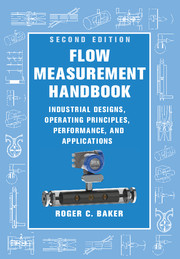Book contents
- Frontmatter
- Dedication
- Contents
- Preface
- Acknowledgements
- Nomenclature
- 1 Introduction
- 2 Fluid Mechanics Essentials
- 3 Specification, Selection and Audit
- 4 Calibration
- 5 Orifice Plate Meters
- 6 Venturi Meter and Standard Nozzles
- 7 Critical Flow Venturi Nozzle
- 8 Other Momentum-Sensing Meters
- 9 Positive Displacement Flowmeters
- 10 Turbine and Related Flowmeters
- 11 Vortex Shedding, Swirl and Fluidic Flowmeters
- 12 Electromagnetic Flowmeters
- 13 Magnetic Resonance Flowmeters
- 14 Ultrasonic Flowmeters
- 15 Acoustic and Sonar Flowmeters
- 16 Mass Flow Measurement Using Multiple Sensors for Single-Phase Flows
- 17 Multiphase Flowmeters 508
- 18 Thermal Flowmeters
- 19 Angular Momentum Devices
- 20 Coriolis Flowmeters
- 21 Probes for Local Velocity Measurement in Liquids and Gases
- 22 Verification and In Situ Methods for Checking Calibration
- 23 Remote Data Access Systems
- 24 Final Considerations
- References
- Main Index
- Flowmeter Index
- Flowmeter Application Index
20 - Coriolis Flowmeters
Published online by Cambridge University Press: 05 August 2016
- Frontmatter
- Dedication
- Contents
- Preface
- Acknowledgements
- Nomenclature
- 1 Introduction
- 2 Fluid Mechanics Essentials
- 3 Specification, Selection and Audit
- 4 Calibration
- 5 Orifice Plate Meters
- 6 Venturi Meter and Standard Nozzles
- 7 Critical Flow Venturi Nozzle
- 8 Other Momentum-Sensing Meters
- 9 Positive Displacement Flowmeters
- 10 Turbine and Related Flowmeters
- 11 Vortex Shedding, Swirl and Fluidic Flowmeters
- 12 Electromagnetic Flowmeters
- 13 Magnetic Resonance Flowmeters
- 14 Ultrasonic Flowmeters
- 15 Acoustic and Sonar Flowmeters
- 16 Mass Flow Measurement Using Multiple Sensors for Single-Phase Flows
- 17 Multiphase Flowmeters 508
- 18 Thermal Flowmeters
- 19 Angular Momentum Devices
- 20 Coriolis Flowmeters
- 21 Probes for Local Velocity Measurement in Liquids and Gases
- 22 Verification and In Situ Methods for Checking Calibration
- 23 Remote Data Access Systems
- 24 Final Considerations
- References
- Main Index
- Flowmeter Index
- Flowmeter Application Index
Summary
Introduction
This is one of the most important meter developments, and its application is impinging on many areas of industry. Its importance has been recognised by the national and international advisory bodies (see Mandrup-Jensen 1990 for an early description of work in Denmark on pattern approval and ISO developments).
Background
Plache (1977) makes the interesting point that mass cannot be measured without applying a force on the system and then measuring the resulting acceleration. This is a point which the present author has long considered a possible requirement and it is certainly supported in the Coriolis meter.
Possibly the first application of the Coriolis effect for mass flow measurement was proposed by Li and Lee (1953) [but see Wang and Baker (2014) for other possible contenders for the original concept]. The meter is shown in Figure 20.1. The T-piece flow tube rotated with the outer casing and was linked to it by a torque tube. As the flow increased, so the T-piece experienced a displacing torque due to the Coriolis acceleration and this was measured from the displacement of the T-piece relative to the main body.
In the Li and Lee meter the liquid was forced to move radially and therefore a force was applied to it through the tube. This force in turn was balanced by an equal and opposite one applied by the liquid to the tube. The force caused the tube to twist and the small relative rotation was sensed to obtain the mass flow rate.
It is interesting to note that Stoll (1978) made no mention of the technology which was to revolutionise mass flow measurement. Medlock (1989) referred to several designs which, although not identified as dependent on the Coriolis effect, have a very similar basis. Macdonald (1983) described a vibrating vane flowmeter. Vsesojuzny (1976) described a vibrating nozzle flowmeter (Figure 20.2) [cf. Hemp's (1994b) work on vibrating elements]. Finnof et al. (1976) described a vibrating tube flowmeter (Figure 20.3).
Tucker and Hayes (1982) analysed the error in oil flow rate for a vibrating pendulum two-phase flowmeter invented by Rivkin (1978) and its suitability for North American oil well applications. Reimann, John and Muller (1982) tested a True Mass FlowMeter (TMFM) on a steam-water loop.
- Type
- Chapter
- Information
- Flow Measurement HandbookIndustrial Designs, Operating Principles, Performance, and Applications, pp. 560 - 602Publisher: Cambridge University PressPrint publication year: 2016



